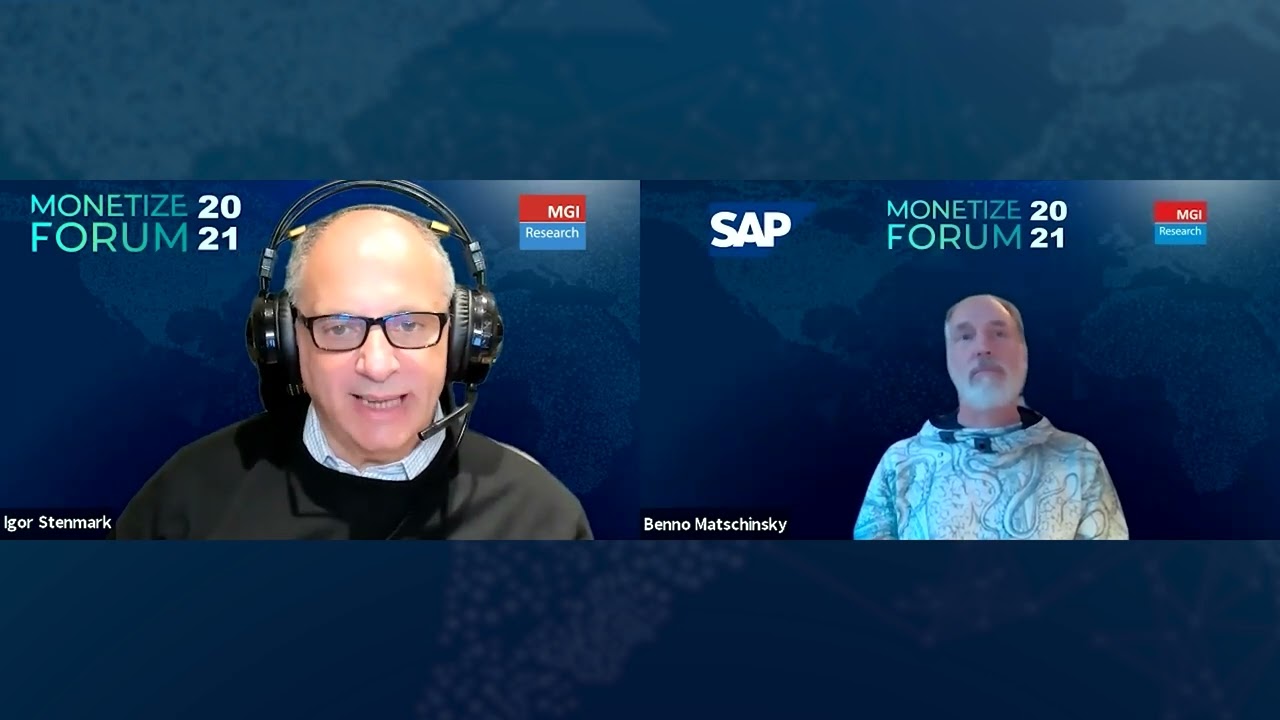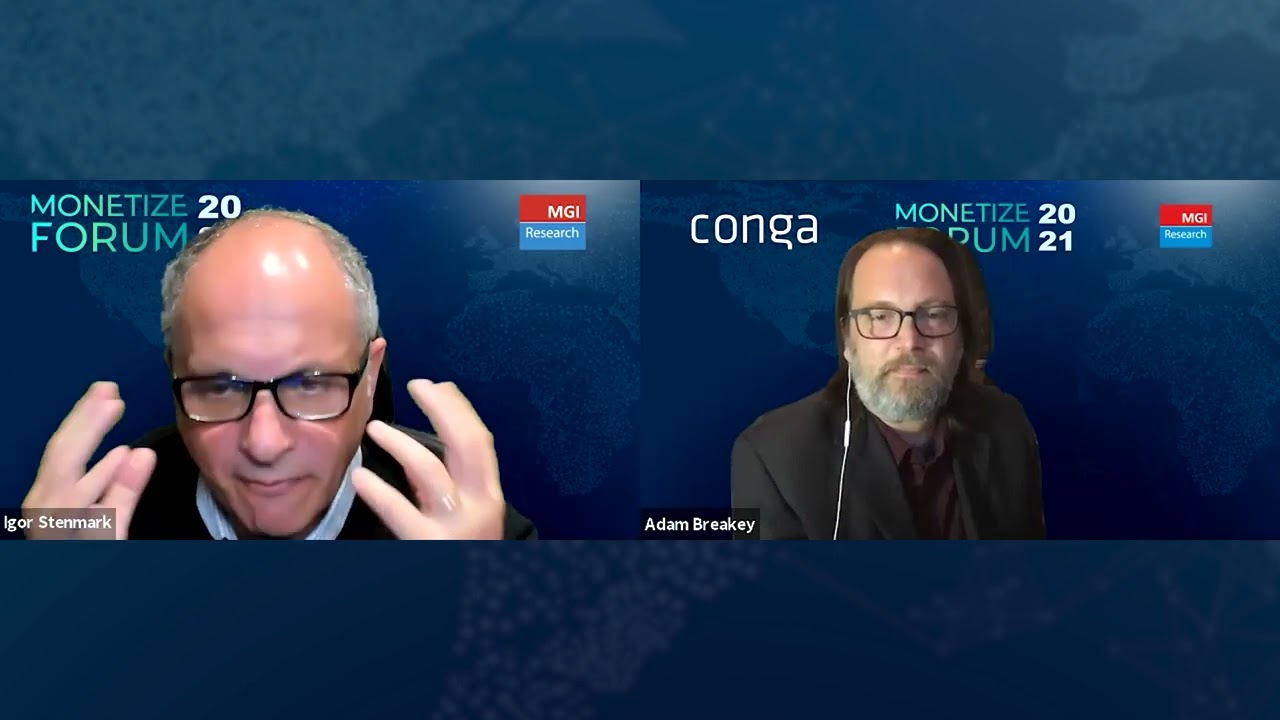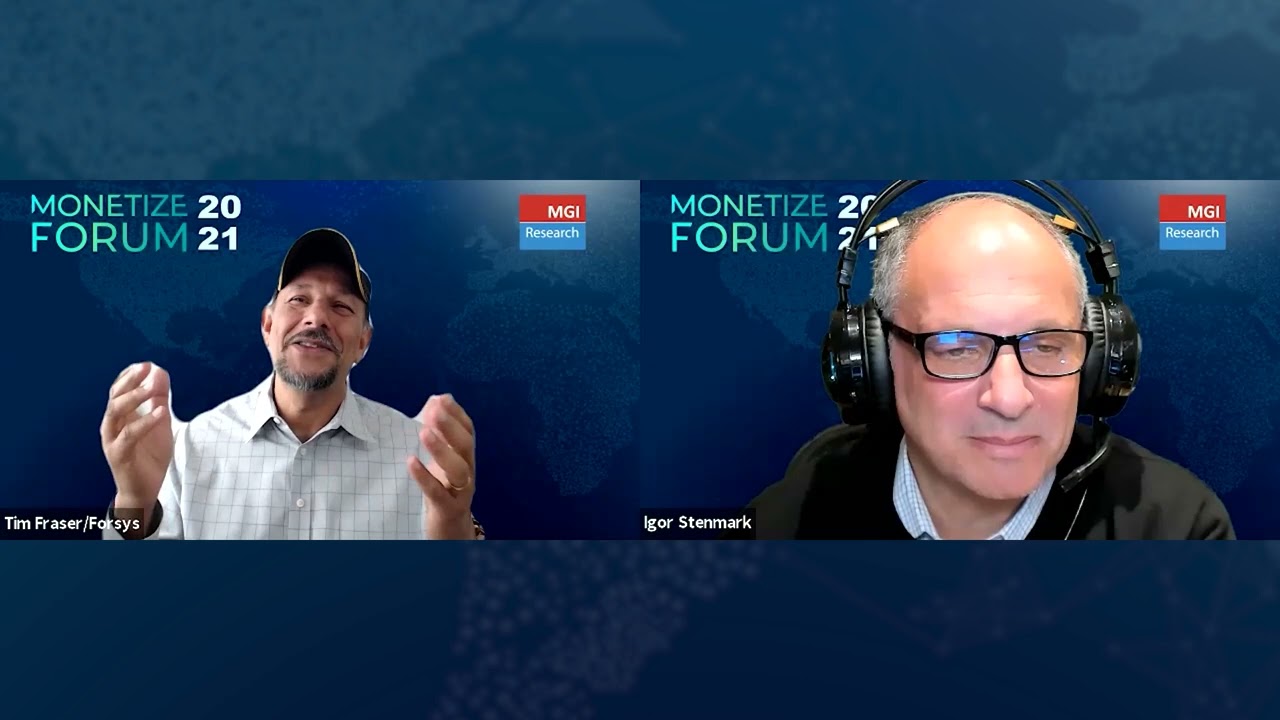
When Apttus and Conga, industry leaders in quote-to-cash solutions and digital document transformation respectively, came together last year, the result was a reimagining of how to generate immediate and lasting wins for their now 10,000-plus customers through the concept of “peak commercial performance for every possible tomorrow.” To tell us more about this initiative, we invited Eric Carrasquilla, Conga’s Senior Vice President of Product to speak with MGI Research analyst Andrew Dailey at the 2021 Monetize Forum. Their discussion also covers how to enable data-driven conversations across organizational boundaries and which new innovations are facilitating process automation.
Key Issues
How does the concept of commercial operations transformation facilitate company wins?
What are the roadblocks that prevent businesses from realizing automation?
What new processes are allowing companies to increase revenue by leveraging data?
Guest Profile
Eric is Senior Vice President of Product at Conga and is responsible for the vision, design, and delivery of Conga’s product portfolio.
Prior to Conga, Eric served as SVP of Product at Model N and held various product and marketing leadership roles at [24]7.ai, Amdocs, Baan, and Fujitsu. Eric holds an MBA from Santa Clara University and a BS in Marketing from San Jose State University.
Andrew Dailey
Welcome to our session, “A Maturity Model for Quote to Cash.” At MGI Research, we often get the question: which companies do monetization best? Who are the public examples of a world-class prospect-to-disclosure or quote-to-cash process? Now, we remind folks that monetization is a capability. It’s comprised of processes, people, and tools that together help a company turn demand into revenue. So, the short answer to the question—which is a serious question—is that no single company does everything right.
Some organizations are world-class at architecture. Some have extremely granular billing. Some are fantastic at frictionless quoting or providing frictionless commerce on a global scale. What’s important to recognize is that monetization overall is a journey, and each company needs to look at where it can obtain the biggest impact, the most quickly, and with the least amount of risk to the business. To discuss this journey, I’m joined by Eric Carrasquilla, the Senior Vice President of Product at Conga. Welcome Eric, and thanks for joining us here at the Monetize Forum.
Eric Carrasquilla
Thanks, Andrew. I’m glad to be here.
Andrew Dailey
Let’s jump right into it here. You’re now Conga, but previously as Apttus, you were one of the first companies to bring this notion of quote-to-cash to the forefront. Today, as the newly formed Conga, your vision has evolved to encompass the notion of what you call “commercial operations transformation” with a focus on legal revenue and business ops. What drove this shift in your thinking about quote-to-cash, and how did the merger of Apttus and Conga shape your thinking?
Eric Carrasquilla
Yes, that’s a good question. We got into a discussion as a leadership team around what winning was for our customers, and quote-to-cash didn’t quite necessarily ring on what a win was. What we came up with was this idea of “peak commercial performance for every possible tomorrow.” That concept broke down into two key ideas. The first piece was peak commercial performance. The win there is around sustained profitable growth. The second part, “every possible tomorrow,” is about helping customers navigate through hurdles that they run into as they grow from where they are to that sustained profitable growth. With that definition of winning for companies, we saw where quote-to-cash in and of itself fell a little bit short.
Firstly, in just looking at quote-to-cash, it assumes everything starts with a quote in the linear flow, and as you really dig in across industries, this isn’t necessarily the case. In some cases, it might start with an agreement. In some cases, there might not be a quote at all. So, this was one piece that we looked at. The second thing was around the teams involved with this. In our initial thinking about quote-to-cash, this was predominantly the sales teams. As we started unpacking that a bit, there were a lot more functions that are involved on the legal operation side and business operation side of things that are in support of the sales teams, and they need to work together in order to transform. Then, the last piece that we looked at is that, for a lot of these companies, this doesn’t happen overnight by flipping a switch. They transform over time and move in capabilities up the maturity curve. With that view of what winning was for our customers in mind, we looked at this and said, “Hey, this isn’t quote-to-cash. This is more of a transformation of their commercial operations to help them get to peak commercial performance.”Andrew Dailey
Yes, I completely agree. For most organizations, as you’re describing, improving their monetization capabilities or performance is really a multi-year endeavor comprised of multiple projects that often include fully digitizing contract management; rationalizing SKUs; and implementing a disciplined governance model for managing prices, products, offers, and more. So, Conga recently introduced a maturity model to help organizations self-assess and identify the right measures to take as part of this monetization endeavor. What led your thinking in building that model, and what went into the creation of it?
Eric Carrasquilla
This kind of relates to what I said about not being able to flip a switch. There are very few companies that are doing that great across the board, so we spent a lot of time within our customer base. The combined company has 10,000-plus customers across multiple industries and in multiple stages from a growth perspective. That helped us get a very good view on what good versus great was, the different patterns of the sequence in which customers would solve problems, and the benefit they would get around that. A lot of that is iteration, going through, and working with customers as well. So, being able to look through and help customers get incremental wins and show them what other best-in-class companies are doing provides them a much more measured approach and more of a menu that they can choose from, versus a one-size-fits-all method.
Andrew Dailey
I know it’s still early days in terms of your induction of the model, but what have been some of the early, outlier surprises and unexpected benefits that you’ve seen so far?
Eric Carrasquilla
You would think the larger companies are doing this better and the smaller companies not as well. One of the surprising pieces is that some of the best examples we found are from the smaller companies that have done this transformation, and some of the bigger companies are at the lower end of the maturity curve.
There’s a multibillion-dollar manufacturing company that we spent some time with that’s still doing quoting based on Excel. Within the short term, the biggest win for them relates to cycle time and approvals, the kind of benefits they can get from cutting that in half, and how that relates to preventing revenue leakage. It’s just a very elemental thing, and you think, “Hey, this is something that was solved long ago. Who’s still doing quoting by Excel—especially at the level of a larger, multibillion-dollar company with significant financial resources?” But those things still persist out there, and from a benefit perspective, that’s a situation where we can go in very quickly (within 90 days) and do more than just cut cycle time in half. In this particular case, we were able to bring it down over 80% and help the team have a much more data-driven discussion with their sales organization related to where they’re discounting, why, and what the financial impact of that is.
Andrew Dailey
We’re big believers in structured approaches and structured maturity models, and in our experience, the benefit of those models is that they help facilitate, like you said, a data-driven conversation. They take it out of a very narrow view and put the conversation into a broader context that the whole organization can understand and get behind.
Related to that, one of the effects of the pandemic is the exposure of where companies have manual gaps in their processes. During the height of the pandemic last year, we saw it was really impossible to hide the areas that were either unautomated or semiautomated. You and I worked at one of the largest enterprise applications companies back in the 1990s, and you’ve been working in this space for decades. Putting the pandemic aside, what’s been holding companies back in terms of being able to more fully automate all of their processes?
Eric Carrasquilla
I think there are a few things. I don’t think there’s one universal reason. One of the things I’ve seen is, if the business process a company is looking to automate hops an organizational silo—if it’s something that goes between sales and finance, or finance and legal, or legal and operations—that’s a tricky thing because it requires folks to speak to each other, and in larger organizations, that doesn’t happen as much across organizational boundaries.
I think the second thing is the inability to deal with amplified complexity with a purpose-built application. We see this a lot on the CPQ side of things where a system will be put in, but when you start adding things, saying, “Hey, we’re going from perpetual to subscription,” or “We’re doing bundling with physical and digital goods and services,” or “We’re not just dealing with hundreds of users; we’re dealing with thousands of users,” that’s where you start to see the stress fractures around components.
The last piece is just the changes in technology and the underlying platform. If the applications have not been built and deployed in a componentized way, it requires these very difficult sweeping changes. So, they’re all solvable problems, but those are the three reasons I think companies have been held back over time.
Andrew Dailey
One of the ways that organizations have historically tried to make major changes in the business and the business processes is by bringing in the big IT project built around a “core system,” and that becomes a rallying cry to help drive organizational change across departments, for example. Do you think it’s more important for organizations to orient first around a platform and then look at applications? Should they add business applications independent of the platform? Should they be looking at individual point solutions? Should they look at who has the most breadth of capability? How do you think about that, and what do you recommend for people?
Eric Carrasquilla
I think the first piece is to be very, very clear on what problems you’re looking to solve and what the sequence is for how you’re going to go through and solve those. I see a lot of companies start with technology first before that point, and they kind of build and paint themselves into a corner. So that’s the first piece which kind of links to what we were talking about before—the maturity model being one of those tools that asks, “What do we want to be when we grow up, and what trade-offs are we willing to take in order to get there?”
The second piece is to avoid what I would call “the California fire problem.” For those not familiar with this, we’ve had a series of wildfires in California over the last few years. One of the byproducts is these giant, rolling blackouts over huge geographical areas. Even though the fire only threatened a component of the grid, because it wasn’t componentized, everything had to come down around it. So, as you’re putting in technology to solve particular problems, doing it in a modularized way that doesn’t require sweeping technological changes, sweeping upgrades, and bringing everything down in order to make a change in one part of the business is definitely what you want to aim towards as much as possible.
The third piece is the focus on the applications at hand. Of course, you don’t want a patchwork of 90 different vendors. The more you can go through and consolidate, the better. However, there needs to be a good balance between that modularity and being able to get the economies of scale around the platform for a vendor. The summary thing I’d say, though, is to really start with that problem you want to solve first because that’s going to drive a lot of whether or not you go with “best-of-breed” or everything under the sun from one vendor.
Andrew Dailey
Yes. Certainly in the last couple of years in technology, there has been a whole conversation on microservices and the componentization of applications. Where do you see the new opportunities for innovation—particularly in process automation around workflow, which really gets to the heart of automating some of these areas of the business that were previously unautomated or semiautomated?
Eric Carrasquilla
I think there are a couple of areas that are really exciting. The first one is around the general concept of what some folks call process mining. One of the fortunate byproducts of the digitization of all these business processes is there’s now a critical mass of these digital breadcrumbs from different parts of the organization. You can go back through this to really understand, in an end-to-end flow, where the bottlenecks are and what you can do to remove those by material amounts. This is something that’s at the top of Maslow’s Hierarchy of Needs and requires going through, having the step digitized first, and solving the manual problem that you talked about before, but we’re seeing a lot of great insight there, particularly around the cycle time area.
The second thing I’d point out is around this concept of one-click. Whether it’s related to ordering, an agreement, a quote, or how you go through and price things, it’s also based on being able to take advantage of these digital breadcrumbs and the implicit needs analysis versus just the explicit ones. The result is the ability to come up with recommendations within 90% accuracy at different moments of truth along that chain: What’s the best price plan for a customer? Which quote is going to have the best hit rate? What are clauses that are going to have the highest probability of being accepted with the lowest risks? So, a lot of what we’re really excited about is data-centric and around mining and recommendation.
Andrew Dailey
One-click—very cool. We’re almost out of time, but tell me one thing that every CXO should know about Conga but doesn’t.
Eric Carrasquilla
I think most CXOs might be familiar with Conga as a document generation company or Apttus as a quote-to-cash company. With the two together, though, the thing every CXO should know is probably that, as far as commercial operations transformation (what we talked about earlier) and helping them win with sustained profitable growth, we are a leader in the space. We have 10,000-plus customers and tons of great outcomes for companies, whether they’re at the starting point of that journey or they’ve hit the top of that hierarchy of needs. We are a leader, and we can help them win.
Andrew Dailey
Well, Eric, thanks very much for joining us. I’ll remind everyone that there’s more information at the Conga booth, and I’m sure you’ll be around for the networking and happy to answer any questions. So, thanks again, and enjoy the rest of the Monetize Forum.
Eric Carrasquilla
Thanks, Andrew.




